Flare Tests Enlightening
Foundation Findings #45 - November 2008
In 1998, when the Foundation originally conducted testing on flares, there were 5 - 6 different manufacturers.
Today there are two, marketed under three different brand names in the United States. Though the market appears to have undergone some shrinking, there is still a wide variety of models to choose from.
SOLAS options, especially, have expanded SOLAS stands for Safety Of Life At Sea and is a standard set by the International Maritime Organization for offshore boating safety equipment. Almost half of the pyrotechnic signaling devices we tested were SOLAS approved in addition to being approved by the U.S. Coast Guard. We also tested some devices that are not yet approved by either organization.
The Shopping List - Flare Types
Aerial flares can include parachute rockets which descend slowly from a high altitude and burn for more than 30 seconds; or meteor aerials which burn for less than 10 seconds. Most parachute flares are SOLAS approved and meteor flares are not SOLAS approved. The aerial flares we tested include:
- Orion Red Parachute Signal Rocket - SOLAS
- Pains Wessex Para Red Rocket MK8 - SOLAS
- Comet Red Parachute Signal Rocket - SOLAS
- Orion 25 MM Red Aerial Flare
- Orion 25 MM Red Aerial Parachute Flare
- Orion 12-Gauge High Performance Red Meteor Flares
- Orion Skyblazer Red Aerial Signal Kit
- Orion Pocket Rocket Red Aerial Flares
Handheld flares are usually red in color but white collision flares are also available. The white flares are not SOLAS or USCG approved. The handheld flares we tested were:
- Orion Handheld Red Locator Flares
- Pains Wessex Red Hand Flare MK8 - SOLAS
- Comet Red Handflare - SOLAS (not pictured)
- Orion Red Handheld Flare - SOLAS (not pictured)
- Orion White Handheld Signal
- Pains Wessex White Collision Hand Flare MK8
- Pains Wessex Day/Night Signal (not USCG approved)
Smoke flares are best for day use and can be either a handheld version or a throwable floating smoke canister which are usually SOLAS approved. The smoke flares we tested include:
- Orion Handheld Orange Smoke Signal
- Orion Floating Smoke Signal - SOLAS
- Comet Smoke Signal Orange - SOLAS
- Pains Wessex Lifesmoke MK8 - SOLAS
- Pains Wessex Manoverboard MK2 - SOLAS
We also tested some non-pyrotechnic distress signals including a bright orange distress flag, a blinking SOS distress light and some new LED lights and lasers that are not USCG approved. The non-pyrotechnic signals we tested include:
- ACR Electronic DistresS.O.S. Night Visual Distress Signal
- Orion Distress Flag
- Powerflare P/F 200 Safety Light
- Red Greatland Rescue Laser Flare Magnum
- Greatland Green Rescue Laser Flare

SOLAS Approved Parachute Flares
SOLAS approved parachutes were designed so that other equipment isn't necessary for firing. No need for a separate gun or pen style launcher - which require multiple steps for use. And if you have lost your launcher or found yourself with a broken launcher, you'd be left holding an unusable flare and no way to signal for help.
To launch the parachute flare, you must hold the flare at arms length and fire it close to vertically. Launching this flare for the first time can be a challenge, as our testers had no way to judge how it would recoil, or whether or not anything would come out the bottom of the flare when discharged. After some practice they found that the recoil was minimal but aiming them was harder than expected, particularly those that use a push-tab for the firing mechanism.
Orion Red Parachute Signal Rocket - SOLAS
This flare performed well. Brilliance and illumination time were on par with other SOLAS parachute type flares, though we found that it did not travel as high as the other parachute flares, and it also tended to 'corkscrew' and not fly as straight as the other parachutes. We also found that the instructions on the flare were difficult to read, as the typeface seemed blurry and the ENGLISH instructions were lost among other languages.
Pushing the metal firing tab, which is the most important task for launching, was not intuitive from the directions. And fiddling with the firing tab made it difficult to hold the large diameter flare in a vertical direction which in turn made it difficult attaining the highest trajectory.
Pains Wessex Para Red Rocket MK8 - SOLAS
Comet Red Parachute Signal Rocket - SOLAS
The Pains Wessex and Comet rockets are manufactured by the same company, and performed very well. We found there to be little difference between them, other than the directions printed on them. The Pains Wessex directions were more user friendly because of the pictograms, which our testers preferred over directions on all other products. Our testers also found the ribbed handle on both units made it an intuitive and natural place to hold the flare, and it also helped to minimize apparent recoil. The firing mechanism, a pull lanyard, made it easy for our testers to aim straight and took the anxiety out of the aiming process. This flare was a top choice among testers.

USCG Approved Aerial Flares
U.S. Coast Guard approved aerial flares have less demanding operational performance specifications than SOLAS flares. These flares typically had a burn time of approximately 6 seconds and an altitude of 300 feet.
This pales in comparison to SOLAS flares that burn for about 40 seconds and an altitude greater that 900ft. Unlike SOLAS flares which have built in firing mechanisms, there is a wide array of ways to fire USCG flares, ranging from built-in (Skyblazer) to a pistol type launcher. More on firing mechanisms later...
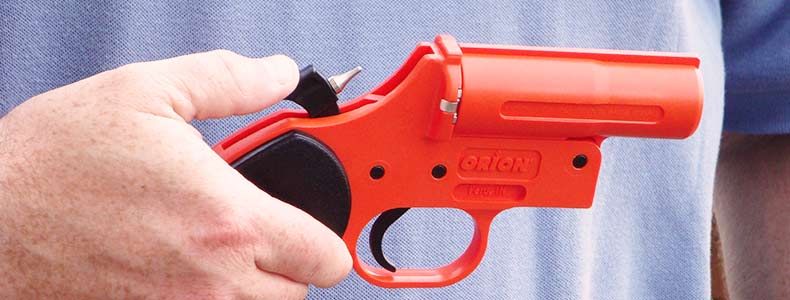
Gun-Style Flare Launchers
Orion 25 MM Red Aerial Flare - USCG
Orion 25 MM Red Aerial Parachute Flare - USCG
Orion 12-Gauge High Performance Red Meteor Flares - USCG
The 12 Gauge and 25 MM flares use a pistol style launcher for both meteor and parachute flares.
The 12 Gauge version only fires meteors while the 25 MM version fires both meteors and parachute flares. Both meteor flares are lit as soon as they exit the barrel. The 12 Gauge pistol is made of plastic, and is much smaller than the substantial, metallic 25 MM pistol.
The 25 MM parachute, just like the SOLAS parachute flares, is not lit until it reaches its highest trajectory which is several seconds after it is fired. The 25 MM gun launcher has a blue barrel insert which can be used to adapt the 25 MM gun to fire 12 Gauge shells. The 25 MM parachute achieves near SOLAS heights and illumination time. For some boaters, the 25 MM pistol offers you the best options - you can use 12 Gauge meteor shells, 25 MM meteor shells, and 25 MM parachute, the latter of which has SOLAS like performance.
All three of these flares were difficult for our observers to find during the day. They're bright, but barely bright enough to see against a midday sky. At night, however, the reflection off the water doubles the effectiveness and really grabs your attention. Not to mention they make for really fun photos, as you see at right.
Pocket-Sized Aerials
Orion Skyblazer Red Aerial Signal Kit - USCG
The Skyblazer is the only USCG approved aerial flare tested that had a built in firing mechanism. It's a flare that is compact, waterproof, and floats, making it a good choice for small craft (we felt it would be great for PWC and Canoe/kayak operators) as well as the individual offshore boaters that might like the added safety of storing them in a life jacket pocket or foul weather gear jacket.
Some of the trade-offs of the Skyblazer were that testers felt that the directions were very small and not descriptive enough to feel confident that they were firing the flare properly. This was magnified because of the units' small size-which also gave the impression of having more apparent recoil than the bulkier SOLAS models. Proper hand placement on the device is imperative-holding it improperly can lead to excessive recoil and potential injury.
Orion issued a safety notice about their Skyblazer product on 9/26/2008 indicating a possible risk of minor injury when using this product. Revised instructions were subsequently issued to prevent such injury and the product design has been modified.
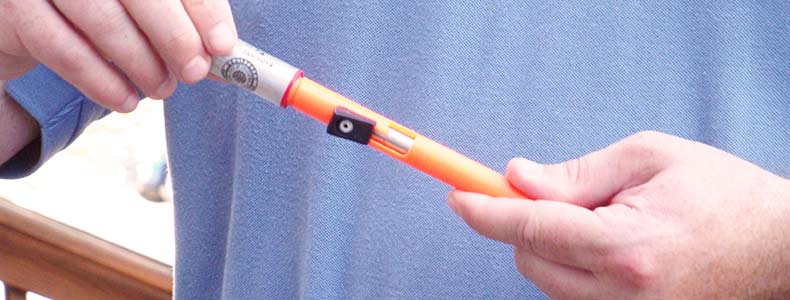
Orion Pocket Rocket Red Aerial Flares
Like the Skyblazer, this compact flare is just the right size for a personal watercraft and light craft users. The kit, which includes a waterproof container, holds 3 red aerial shells/cartridges along with a pen style launcher. While we were impressed with the value of the kit, we did find the mechanics of the product challenging to use. The spring-loaded trigger on the launcher was difficult to pull down and cock. Likewise, the tension on the firing mechanism made it difficult to release the trigger to actually fire the device. Eye protection and ear protection were a must for our testers. Lacking a launching barrel, this flare sprayed our tester with small shell fragments when fired and was incredibly loud.

Smoke on the Water
Smoke flares were by far the most visible signal during the daylight portion of our test. Also, our testers were not reluctant to use smoke flares because they perceived them to be less dangerous to use. This was especially true for the floating smoke flares since they are thrown in the water after activation. While some flares meet both day and night carriage requirements, smoke flares only meet day time carriage requirements.
One observation was that smoke flares do better in calm conditions. That is another reason why floating smoke canisters seemed to perform so well-they keep the discharged smoke lower to the water resulting in a more concentrated cloud.
If you use handheld smoke, we do not recommend waving the smoke flare like you might do with a handheld flare, as it tends to dissipate the smoke more rapidly.
Orion Handheld Orange Smoke Signal - USCG
The Orion handheld smoke flare relies upon the same type of firing mechanism as the Orion Handheld Red Locator Flares, a match-strike top. The flares and smoke signal are also approximately the same shape and size-which might lead to confusion on a dark and stormy night. Coming in a package of 3, each handheld smoke flare has a burn time of just more than a minute. One benefit of the smoke signal is that the tube doesn't burn down like the red flare does, so you don't have to worry about hot slag dripping on you or your boat.
Orion Floating Smoke Signal - SOLAS
Comet Smoke Signal Orange - SOLAS
Pains Wessex Lifesmoke MK8 - SOLAS
All of our SOLAS approved floating smoke flares performed relatively the same. The activation method was simple and straight forward, with all using a pull lanyard or ring. The fact that you didn't have to hold the flare after activating it removed a perceived danger element. Since the canister floats in the water, the smoke released tends to stay more condensed just over the waters surface. The SOLAS approved floating smoke canisters are far larger than the USCG handheld model, and as a result have a burn time of three minutes, which is roughly three times longer than the handheld models.
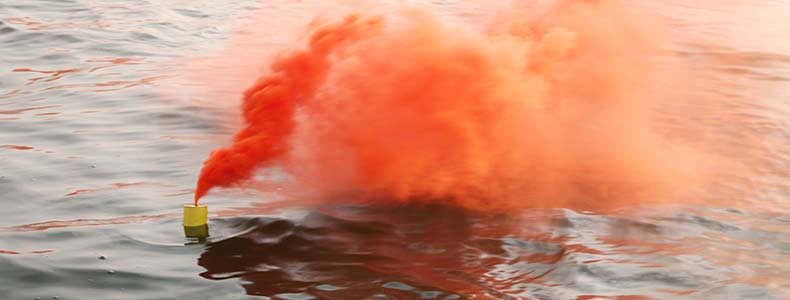
Pains Wessex Manoverboard MK2 - SOLAS
The Manoverboard MK2 was the most impressive day visual distress signal we tested because of the shear volume of smoke it released. Far exceeding SOLAS standards, for over 20 minutes this flare discharged its bright orange smoke. It was a calm day for our test and the product still drifted more than a quarter mile away from our anchored test boat after activation. There is also a 'strobe light' on the device, though observers failed to see the light at all, and the notion of a light on a daytime smoke device seems a little out of place.
Weighting in at closed to 9lbs and shipped with permanent mounting bracket, we simply took it out of its bracket, activated it, and threw it in the water. Because of the shear volume of smoke, long activation time and large size, this is an ideal flare for large offshore vessels. At a price over $450, coupled with the 42 month limited lifespan this product is not a practical safety device for most boaters.
Give Me a Hand - Handheld Flares
Handheld flares were probably the most intimidating devices to use of all the products tested. While the handheld flares were activated via a variety of different methods, for most, the firing mechanism was on top of the flare. This meant that 1-2 seconds after our testers ignited the flare the pyrotechnic would come out of the same location that their hand was just over.
Standard practice for using the flare was for our testers to hold them over the side of the boat at arms length. With more than a minute of burn time, we can see that in any type of rough weather this would be a difficult task. The importance of wearing gloves was a lesson we quickly learned. With the hot part of the flare in such close proximity to our tester's hands they could have easily been burned by the glowing white metal tube or the slag discharging from many of them.
During the day our shore team was unimpressed by their performance compared to the visibility of the smoke flares. At night though, hand flare were "brilliant". Handhelds at night lit up the whole boat and left its occupants seeing spots for several minutes. The manufacturers use the same design for both red and white handhelds. Minor differences in appearance such as color and labeling were the only recognizable distinction between them. Unfortunately, with so little difference in appearance, users will have to be diligent not to activate the incorrect flare.
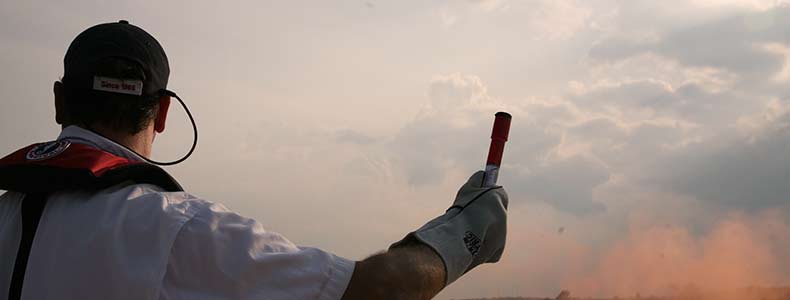
The Common Handheld
Orion Handheld Red Locator Flare - USCG
The flare that is probably the most popular handheld on the market seemed to our testers to be one of the most dangerous. Using the same ignition method as the Orion Handheld Orange Smoke Signal, our testers found the 'match strike' temperamental to get ignited. Given that these were brand new and being used in dry weather, out testers wondered how much harder it would be to light an older flare in wet conditions.
Clearly labeled instructions on the side of the flare state that your hand must be below a designated line during use. The importance of this instruction becomes more evident as the flare burns, because it burns right down to this line before self extinguishing. Since the body of this particular flare burns down, we found it produced more slag than the other handheld flares.
Now That's Hot - SOLAS Handhelds
Pains Wessex Red Hand Flare MK8 - SOLAS
Comet Red Handflare - SOLAS
The Pains Wessex and Comet (same manufacturer) red hand flares differ in only the directions printed on the side of the flares. The color pictograms on the Pains Wessex version were much easier to read and follow than the simple black text found on the Comet.

This is a very compact hand flare consisting of a metal tube that holds the flare, and a plastic outer housing that telescopes down prior to the ignition process. The plastic surface had a ribbed hand hold just like the SOLAS parachute and white handheld flare models. The metal tube does not melt/burn down like the Orion Handheld after activation. With this design the flare contents are burned only at the tip of the flare and this results in a greatly reduced amount of slag. However, the metal tube becomes white hot during activation and we found it necessary to cool them in the water for several minutes before disposing.
Orion Red Handheld Flare - SOLAS
The Orion SOLAS red handheld model is different from the Orion USCG approved model in design. A long handle extends the ignition tip farther away from the hand. Like the other SOLAS models the flare does not burn down to the handle but only at the top end of the flare. This flare burns with more of a yellow/orange color, as opposed to the red found in the Pains-Wessex models. Coupled with the fact that it also produced less smoke than the Pains-Wessex models, the Orion version was deemed to be inferior to the Pains-Wessex for daytime use.
Orion White Handheld Signal
Pains Wessex White Collision Hand Flare MK8
White handhelds are primarily used by the recreational boater to meet the requirements of offshore regattas, for practice (it’s legal to practice with a white flare, but not a red flare) and to signal a warning of imminent danger. Both models use the same design as their SOLAS red handheld counterparts. We did find that the color variation between the products interesting with the Orion more yellow in appearance then the Pains Wessex model. Both models produced a considerable amount of smoke. With our test on a calm day the smoke did affect the visibility of the flare from shore, though it was easier to tell that a flare had been lit. Neither of these models are SOLAS or USCG approved.
Our test used the MK8 model and NOT the MK7. Be sure to review your assortment of flares to ensure the MK 7 is not one of them and follow the recall directions.
Pains Wessex Day/Night Signal
Hand and Smoke Combination Flare
The Day/Night Signal is a combination smoke and hand flare that emits smoke from one end, and a red flare from the other. It is neither USCG nor SOLAS approved which means it does not meet carriage requirements. This interesting product is compact, and it tries to provide the best of both worlds. But with durations of 30 seconds (smoke) and 21 second (hand held) on average, it would probably be best used on a small boat on an inland waterway where rescue is clearly in sight. The compact size and versatility leads us to think it has a place for use by military, aviation and outdoor enthusiasts.
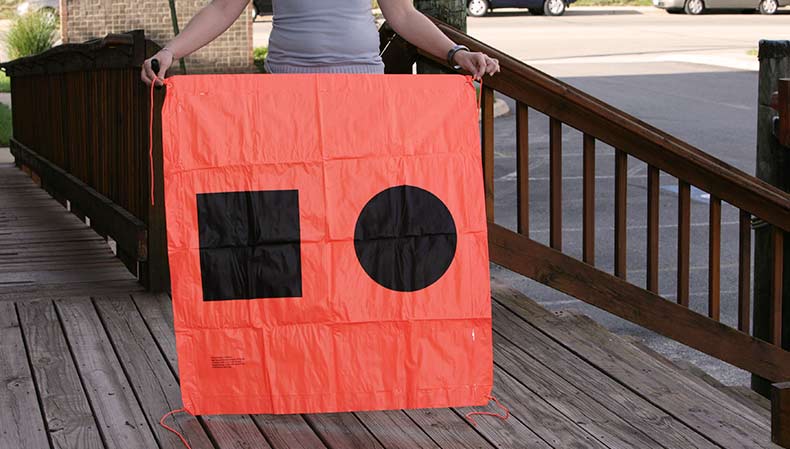
Non-Pyrotechnic Distress Signals
There are surprisingly few non pyrotechnic distress signals on the market that meet US Coast Guard carriage requirements. Besides the federal requirements, some states might have additional requirements. Be sure to review your state's requirements to make sure you are operating legally.
If a flash of light hit you in the eye would you think someone is signaling you? This question arose with non pyrotechnic distress signals. Since these products do not function like pyrotechnic flares there is a concern that the signal, even if seen, will not be perceived to be a call for help. Boaters have become accustomed to reacting when they see a flare in the sky, the same might not be true when they see a red, green or white light, all of which could be confused with navigation lights.
Most of the non-pyrotechnic products on the market today use fairly new technology. Environmental concerns regarding the use of pyrotechnics, such as discharge and disposal, have been one of the driving forces for the development of many of these products now entering the market.
Unlike pyrotechnic flares, many non-pyrotechnic devices rely upon batteries to function. A boater using a battery operated non-pyrotechnic distress signal should check the status of the unit often. A battery replacement schedule with expiration date labeled on the unit will help increase the reliability of the product. Since there's no expiration date, these devices require more diligence than traditional flares. Not only are there dud pyrotechnic flares, a battery-powered non pyrotechnic flare can be a dud if it is not properly maintained.

Lights and Flags
The ACR Electronic DistresS.O.S. Night Visual Distress Signal is not to be confused with a traditional flash light. This product when switched on will signal an S-O-S pattern ( short, short, short, long, long, long, short, short, short). This product meets Coast Guard approval for night use only. We found during our test that the SOS flashing white light could easily be confused with shore lights in a densely populated area. The local lights, or back scatter, made it hard to pick out the SOS light and left us questioning whether another boater or person on shore would respond appropriately-even if they did see it.
The Distress flag when compared to the smoke flares, made a comparatively small impression. At a 1/4 mile our observers could hardly tell what the black shapes were on the flag. Any type of movement in the breeze reduced the viewing area and made it harder for our observers to see. As a last resort the distress flag should be used along with any other impromptu screaming and waving of the arms.
The Powerflare P/F 200 Safety Light is an LED light used in other applications including: military, marine construction, and law enforcement. For most car drivers this is the perfect replacement for a road flare. This product was tested because it is advertised as having boating applications, but we found that brilliance was too week for the boating environment. At 1/4 of a mile we had a very difficult time seeing it but again, it would be good for drivers coming up to a car accident. This product was not Coast Guard approved.
Laser Lights
The Greatland Lasers are high powered rescue devices that have an incredible range of 20 - 30 miles in ideal conditions. The presentation laser pointers with which you might be familiar, focus their laser beam into a small dot-while the Greatland products focus the beam into a linear shape. At a close distance the beam is only a few inches wide but at a 1/4 mile the beam grows to several feet in width. The linear shape enables the user to sweep the beam (held vertically) back and forth across the intended target.
We found this product to be heavily affected by the atmospheric conditions during our night testing and difficult to see at all during our day test. With a half moon and the glow of an urban sky, the red Greatland Rescue Laser Flare Magnum proved to be much more difficult to see than the Greatland Green Rescue Laser Flare. Aiming both of the lasers proved difficult due to the 1/4 mile testing distance as even a moderate amount of 'sweeping motion' by the tester made it difficult for the observers to see the laser. Without radio confirmation it was difficult to tell if the signal was even received. Aiming the green flare into the water and slowly guiding it up to the target proved to be a good method. These products will require a lot of practice to perfect a successful aiming technique.

Final Thoughts
Currently laser signaling devices are not USCG approved. The primary concern with laser signaling devices is that lasers aimed directly at someone's eyes may lead to laser dazzle where an after image of spots makes it difficult for an aircraft pilot to see. This is an issue manufacturers are working to address. A concern for boaters remains that if a pilot gets hit with a laser flare in the eyes they may abort the mission.
For details on the flares and their ratings please see the chart below.
What to Do With Expired Flares?
Unfortunately there is no easy answer to this question. Flares cannot be recycled, and special care should be taken with their disposal. Throwing flares in your household trash can pose a danger for handlers and can pollute ground water. Setting off old flares can result in false distress reports and may result in fines and penalties. To dispose of expired flares there are few options:
- Contact your local public works or sanitation department - some might have house hold hazardous waste days or special drop off sites. You can find waste facilities near you that handle hazardous waste at Earth 911
- Contact your local police or fire department - it is important to contact them by phone first as they might want to prearrange pickup or delivery.
- Check with your local boating retailer for the best method of disposal in the local area.
- Alternatively, check with a local boating education groups such as the Power Squadron or Coast Guard Auxiliary. They often use old flares for demonstration purposes.
| Flare Manufacturer and Name | Time Average (sec.) | Height Average (ft.) | Visibility 1-5 miles | Price | Source | Type |
|---|---|---|---|---|---|---|
| Orion Red Parachute Signal Rocket -SOLAS | 39.1 | 874 | 4.75 | $57.99 | West Marine | Para |
| Pains Wessex Para Red Rocket MK8 - SOLAS | 43.7 | 1015 | 5 | $39.95 | Pyacht.com | Para |
| Comet Red Parachute Signal Rocket - SOLAS | 44.7 | 980 | 5 | $54.95 | USA Services | Para |
| Orion 25MM Red Aerial Parachute Flare - USCG | 33.3 | 1044 | 3.75 | $58.99** | West Marine | Para |
| Orion Skyblazer Red Aerial Signal - USCG (4 pack) | 6.7 | 368 | 2.75 | $46.99 | West Marine | Aerial |
| Orion 12 Gauge High Performance Red Meteor Flares - USCG (4 pack) | 6.0 | 344 | 2.5 | $28.99 | West Marine | Aerial |
| Orion 25MM Red Aerial Flare - USCG (3 pack) | 5.0 | 329 | 3.5 | $59.99** | West Marine | Aerial |
| Orion Pocket Rocket Red Aerial Flares - USCG (3 pack) | 5.7 | 224 | 2.0 | $32.99 | Value Marine | Aerial |
| Orion Handheld Orange Smoke Signal - USCG | 66.0 | n/a | 3.0 | $24.99 | West Marine | Smoke |
| Orion Floating Smoke Signal - SOLAS | 155.0 | n/a | 3.0 | $57.99 | West Marine | Smoke |
| Comet Smoke Signal Orange - SOLAS | 258.0 | n/a | 2.5 | $56.29 | USA Services | Smoke |
| Pains Wessex Lifesmoke MK8 - SOLAS | 245.0 | n/a | 4.0 | $44.95 | Landfall | Smoke |
| Pains Wessex ManOverBoard MK2 - SOLAS | 1288.0 | n/a | 4.0 | $495.00 | Landfall | Smoke |
| Orion Handheld Red Locator Flares - USCG (4 pack) | 163.0 | n/a | 2.5 | $27.99 | West Marine | Hand |
| Pains Wessex Red Hadn Flare MK8 - SOLAS | 64.0 | n/a | 4.75 | $12.95 | Landfall | Hand |
| Comet Red Hand Flare - SOLAS | 68.0 | n/a | 3.75 | $17.13 | USA Services | Hand |
| Orion Red Handheld Flare - SOLAS | 67.0 | n/a | 4.5 | $23.99 | West Marine | Hand |
| Orion White Handheld Signal | 65.0 | n/a | 3.75 | $23.99 | West Marine | White |
| Pains Wessex White Collision Hand Flare MK8 | 63.0 | n/a | 3.5 | $10.99 | Pyacht.com | White |
| Pains Wessex Day/Night Signal (Red Handheld Side) | 21.0 | n/a | 3.5 | $79.99 | Landfall | Combo |
| Pains Wessex Day/Night Signal (Smoke Side) | 30.0 | n/a | 2.5 | $79.99 | Landfall | Combo |
| ACR Electronic DistresS.O.S. Night Visual Distress Signal - USCG | n/a | n/a | 2.5 | $16.95 | Landfall | Non-Pyro |
| Orion Distress Flag - USCG | n/a | n/a | 1.0 | $11.99 | West Marine | Non-Pyro |
| Powerflare P/F 200 Safety Light | n/a | n/a | 0.5 | $49.50 | Powerflare.com | Non-Pyro |
| Red Greatland Rescue Laser Flare Magnum | n/a | n/a | 2.0 | $89.99 | Defender | Non-Pyro |
| Greatland Green Rescue Laser Flare | n/a | n/a | 4.0 | $249.99 | Defender | Non-Pyro |
| ** Cost of shells only. Kit price for the Orion 25mm launcher and parachute shell is $166.55 Kit price for Orion 12 gauge launcher and meteor shells is $54.99 | ||||||

